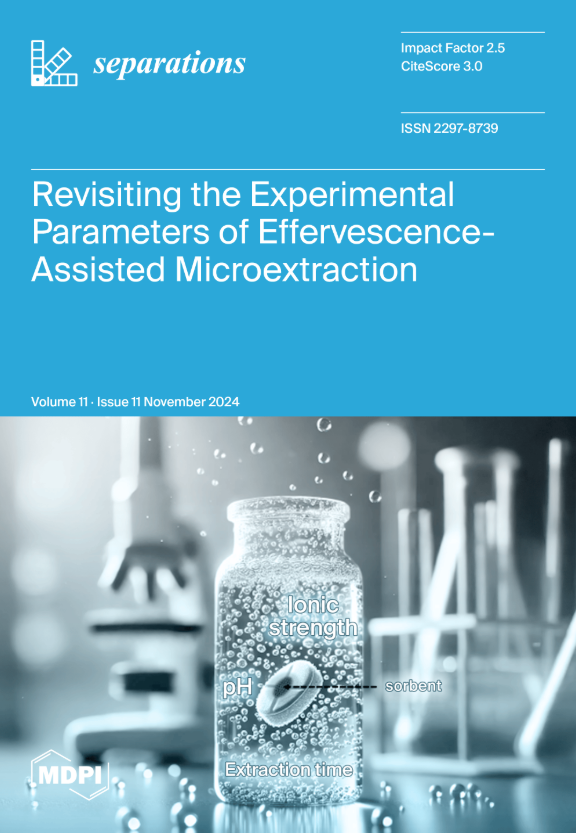Using Kerosene as an Auxiliary Collector to Recover Gold from Refractory Gold Ore Based on Mineralogical Characteristics
IF 2.5
4区 工程技术
Q3 CHEMISTRY, ANALYTICAL
引用次数: 0
Abstract
Carbon–arsenic-bearing gold ore is a typical complex refractory gold resource. Traditionally, xanthate was often used as a flotation agent to separate gold minerals. But, in this paper, in order to reduce the cost of the agent, kerosene was used as an auxiliary collector, and the gold grade and recovery rate were increased by about 10 g/t and 5.5%, respectively. Through process mineralogy studies of the raw ore, it was found that the ore has an Au grade of 5.68 g/t, most of which is surrounded by sulfide ore, accounting for 79.46%. The main minerals are pyrite, arsenopyrite, and quartz, etc. Their content, shape, particle size distribution, and occurrence state were obtained via microscopic observation and statistical analysis. According to the results of process mineralogy, various flotation conditions were tested, including grinding fineness, kerosene dosage, collector dosage, foaming agent dosage, and the slurry pH value. The optimal chemical system and the process flow of “two roughing, three cleaning and two scavenging” were finally determined, and the concentrate product with a gold grade of 42.83 g/t and recovery of 91.02% was obtained, which verified the feasibility of the kerosene-assisted xanthate flotation of refractory gold.根据矿物学特征使用煤油作为辅助收集器从难熔金矿中回收黄金
含碳砷金矿是一种典型的复杂难选金资源。传统上,黄原酸盐常被用作浮选剂来分离金矿物。但在本文中,为了降低药剂成本,使用煤油作为辅助捕收剂,金品位和回收率分别提高了约 10 克/吨和 5.5%。通过对原矿的工艺矿物学研究发现,该矿石的金品位为 5.68 g/t,其中大部分为硫化矿包围,占 79.46%。主要矿物有黄铁矿、砷黄铁矿、石英等。它们的含量、形状、粒度分布和出现状态都是通过显微镜观察和统计分析得到的。根据工艺矿物学结果,对各种浮选条件进行了试验,包括磨矿细度、煤油用量、捕收剂用量、起泡剂用量和矿浆 pH 值。最终确定了 "二粗、三清、二扫 "的最佳药剂制度和工艺流程,获得了金品位42.83克/吨、回收率91.02%的精矿产品,验证了煤油辅助黄药浮选难选金的可行性。
本文章由计算机程序翻译,如有差异,请以英文原文为准。
求助全文
约1分钟内获得全文
求助全文
来源期刊

Separations
Chemistry-Analytical Chemistry
CiteScore
3.00
自引率
15.40%
发文量
342
审稿时长
12 weeks
期刊介绍:
Separations (formerly Chromatography, ISSN 2227-9075, CODEN: CHROBV) provides an advanced forum for separation and purification science and technology in all areas of chemical, biological and physical science. It publishes reviews, regular research papers and communications. Our aim is to encourage scientists to publish their experimental and theoretical results in as much detail as possible. There is no restriction on the length of the papers. The full experimental details must be provided so that the results can be reproduced. There are, in addition, unique features of this journal:
Manuscripts regarding research proposals and research ideas will be particularly welcomed.
Electronic files and software regarding the full details of the calculation and experimental procedure, if unable to be published in a normal way, can be deposited as supplementary material.
Manuscripts concerning summaries and surveys on research cooperation and projects (that are funded by national governments) to give information for a broad field of users.
The scope of the journal includes but is not limited to:
Theory and methodology (theory of separation methods, sample preparation, instrumental and column developments, new separation methodologies, etc.)
Equipment and techniques, novel hyphenated analytical solutions (significantly extended by their combination with spectroscopic methods and in particular, mass spectrometry)
Novel analysis approaches and applications to solve analytical challenges which utilize chromatographic separations as a key step in the overall solution
Computational modelling of separations for the purpose of fundamental understanding and/or chromatographic optimization
 求助内容:
求助内容: 应助结果提醒方式:
应助结果提醒方式:


